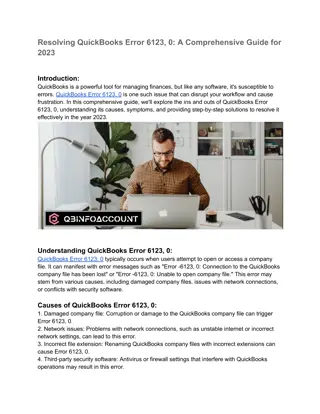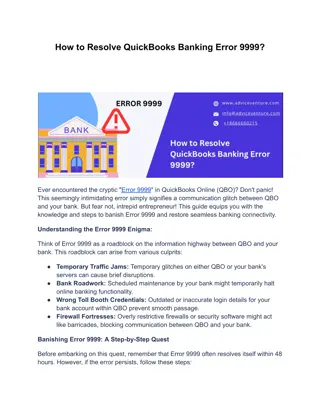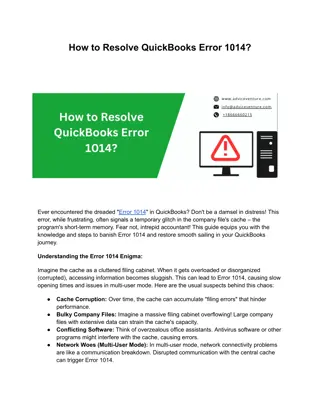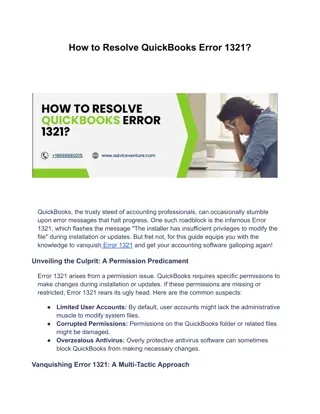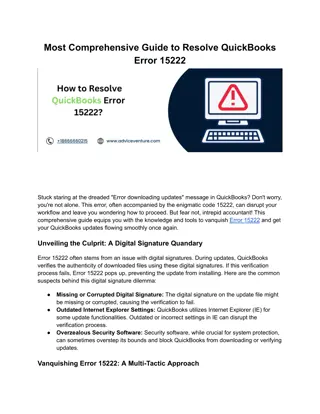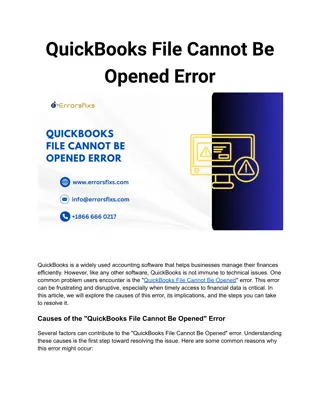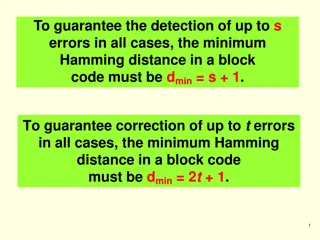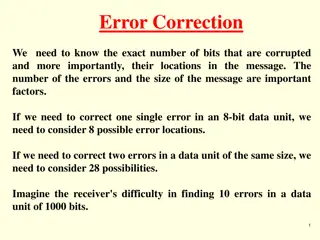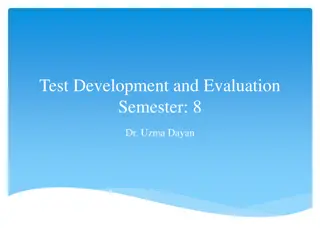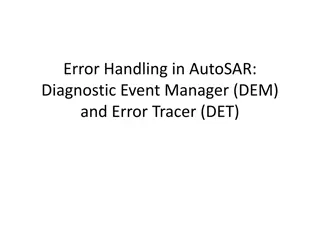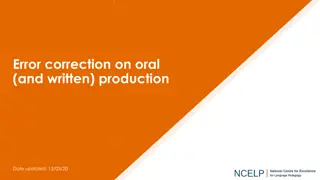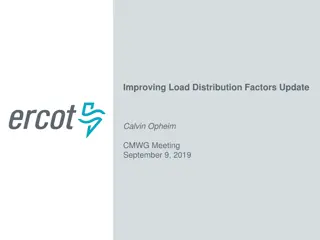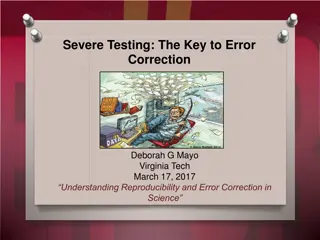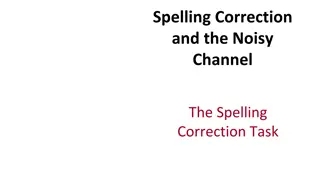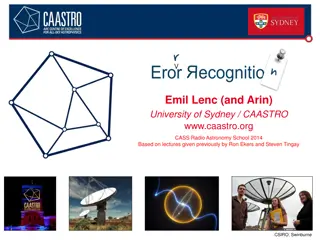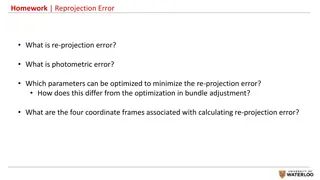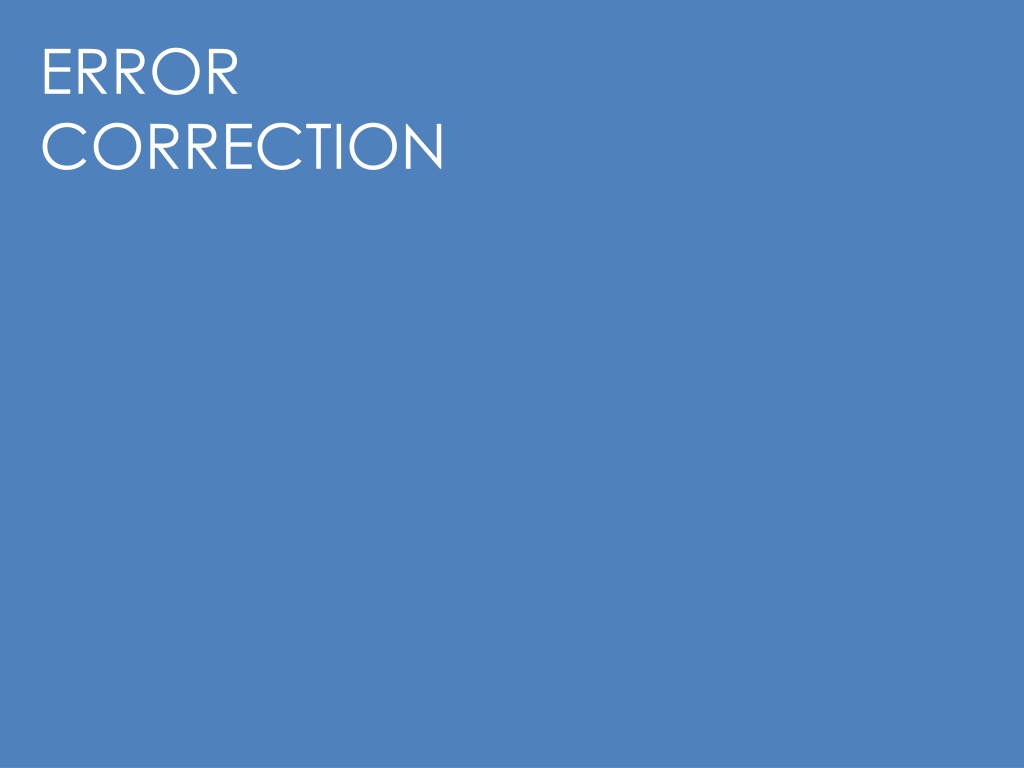
Understanding and Handling Errors in Language Learning
Explore the significance of errors in language learning, differences between errors and slips, why making mistakes is crucial for learners, and the teacher's role in error correction. Discover strategies for recognizing and addressing various types of errors in language usage.
Download Presentation

Please find below an Image/Link to download the presentation.
The content on the website is provided AS IS for your information and personal use only. It may not be sold, licensed, or shared on other websites without obtaining consent from the author. If you encounter any issues during the download, it is possible that the publisher has removed the file from their server.
You are allowed to download the files provided on this website for personal or commercial use, subject to the condition that they are used lawfully. All files are the property of their respective owners.
The content on the website is provided AS IS for your information and personal use only. It may not be sold, licensed, or shared on other websites without obtaining consent from the author.
E N D
Presentation Transcript
ERROR CORRECTION
With which of the following do you have the most sympathy? 1. View 1: errors made by students are evidence that something has gone wrong in the teaching- learning process. 2. View 2: making errors is a natural part of learning a language and should be viewed positively as an opportunity to help the learner.
1. Whats an error? 2. What s a slip? 3. Why do some teachers think it is important for learners to make mistakes? 4. What can teachers learn from learners mistakes? 5. What is the teachers role in relation to learners mistakes?
1.An error is a mistake a learner makes when trying to say something that is above their level of language. They would not be able to self correct an error. 2. A slip is a mistake a learner makes that they are able to correct themselves. 3. Errors are considered to be important because they are an important and necessary part of language learning, learners need to experiment with language in order to work out how language works. 4. Teachers can learn what learners know, what they need to be taught and they can find out what aspects of language they have processed. This enables teachers to adapt their teaching programme. 5. The teachers role in relation to students mistakes is deciding if, when and how to correct.
How do we handle errors? Step 1: RECOGNITION
Find the errors in sentences 1-6 and match them with the classifications (a- f). Then compare your answers with a partner. Errors Classification a problem with word stress 1 'She likes her job. She works for the same company for years.' b problem with intonation 2 (In a restaurant) 'Bring me the menu! c problem with word order 3 'My brother fell off his bike but he wasn't badly damaged.' d problem with choice of word(s) - vocabulary 4 'It's a lovely day, isn't it?' e problem with appropriacy and style 5 'This sofa is very comFORTable.' f problem with the choice of verb form 6 'Where is standing the teacher?'
It is, of course, crucial to know where a learner's interlanguage currently is. There are three reasons (at least) for this.
Reason 1: helps us plan what to teach. Reason 2: point in trying to correct a very elementary student who is trying to produce a complex third conditional form with a modal auxiliary verb because it will take too long and probably confuse the learners. Reason 3: it helps us to recognise whether an error should be corrected by you or whether the error can be self-corrected by the learner. it tells us what the learner is likely to know already and that it helps us to decide what to correct in class. There's little
Why do students make mistakes? The learners own version of the second language which they speak as they learn. They create their own grammatical system as they are learning, which is neither their first language nor the target language but something in between the two. This version of their language changes as they progress and learn more. interlanguage
Why do students make mistakes? 1. When the learner s mother tongue affects their performance in the target language. A learner may make a mistake because they use the same grammatical pattern in the target language as they use in their mother tongue. The L1 grammatical pattern is not appropriate in L2. L1 interference
Why do students make mistakes? The process in which incorrect language become a habit and cannot easily be corrected. fossilisation
Why do students make mistakes? An error made by a second language learner which is natural part of the language learning process because they are unconsciously organising and working out language. These types of error are also made by children learning their first language and often disappear as their language ability improves. developmental error
Why do students make mistakes? When a student uses a grammatical rule he/she has learned, but uses it in situations when it is not needed or appropriate, e.g. a student says There were three girls (correct plural form used for most nouns) and two mans. (incorrect plural form not appropriate for man). overgeneralisation
How do we handle errors? Step 2: how best to deal with it
Jim Scrivener (1994) writes: 1. Decide what kind of error has been made (grammatical? pronunciation? etc.). 2. Decide whether to deal with it (is it useful to correct it?). 3. Decide when to deal with it (now? end of the activity? later?). 4. Decide who will correct (teacher? student self-correction? other students?). 5. Decide on an appropriate technique to indicate that an error has occurred or to enable the correction. To make the decisions above, we must hone our skills. The bigger our knowledge base, the easier to make these decisions, the better we can deal with them. Some suggested error correction techniques are explained below.
Work in pairs. Compare the ways that different teachers responded to the same error. Explain their strategies. S: We go to the cinema yesterday. a. T1: Yesterday - so, grammar? b. T2: c. T3: Not quite, look: We go to the cinema yesterday. [Holds up hand and indicates second finger from left from the learners' point of view.] d. T4: Sorry, do you mean you go every day? e. T5: You went to the cinema - that's nice. Who did you go with? f. T6: makes no comment; the activity continues until, at the end, the teacher says, 'I heard someone say, "We go to the cinema yesterday." Can anyone correct that?' Yesterday, you .... Correction strategy Advantages Easy to use. Disadvantages Learners need to be familiar with the terminology used. a Teacher prompts using Indicates the type of error that the learner should be looking for. terminology, e.g. grammar, tense, pronunciation, etc. (Metalinguistic clues) b Teacher repeats the utterance to the point of the error. e.g. Yesterday you ... self-correction embarrassing Direct / visual learners no one knows your class more than you . c Finger correction (Teacher uses fingers to indicate the position of the error.) Busy with actions d Teacher asks a question, e.g. Do you mean you go everyday? Teacher-centred natural / positive teacher-centred e Reformulation, e.g. You went to the cinema
LEXICAL UPGRADING: I stay in bed longer than usual this morning.
LEXICAL UPGRADING: I wasn t able to relax and worried since the early morning.
Tips from the DIP TESOL diploma Plan with feedback in mind. Anticipate what errors they will make and think about what you can do to help. Build feedback slots into your plan - leave time and space for it. Monitor purposefully. Know what you are monitoring for, how you will gather data, and what you will do with it. Don t leave correction till the end of the lesson, or even until the end of the activity. Feedback on language that ss can use again in that lesson. Plan your board . Remember to contextualise language you board.

